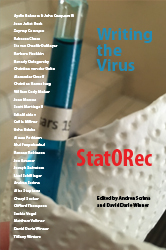
WRITING THE VIRUS: NEW WORK FROM STATOREC MAGAZINE draws from writing published in the online literary magazine StatORec from mid-April to September 2020. Its 31 authors explore the experience of lockdown, quarantine, social distancing, and the politicization of the virus from a wide variety of perspectives. The majority of the texts were written exclusively for the Brooklyn- and Berlin-based journal, and a keen sense of urgency prevails throughout, an understanding that the authors are chronicling something, responding to something that is changing them and the social fabric all around them.
Contributors include Joan Juliet Buck, Rebecca Chace, Edie Meidav, Caille Millner, Uche Nduka, Mui Poopoksakul, Roxana Robinson, Jon Roemer, Joseph Salvatore, Liesl Schillinger, Andrea Scrima, Clifford Thompson, Saskia Vogel, Matthew Vollmer, and David Dario Winner, along with 15 others.
“How to take the temperature of this crisis, this opportunity, this nightmare, this wake-up call? Writing the Virus rounds up a wonderfully diverse array of voices, each addressing—in its own singular, memorable way—all that the pandemic has laid bare. This collection gives us what we need now: talented writers of all stripes, weighing in with honesty, vigor, anguish, and hope. Read this book: it’ll help.” – Martha Cooley, author of The Archivist and Thirty-three Swoons
“The essays and reportage in StatORec’s new anthology are about time, time measured against the presence of the pandemic: Time is upon us. Time may be running out. Time is lost; time is found. The urgent mission is to reflect: What days are these? What manner of people are we? Who will those of us who survive become? This is a new time, in which our Western predilection to plan is revealed as a cardboard construct, blown down by an enemy contained in a breath. Yet with its literary response in real time, this dedicated issue stands as witness to our illusions and our failures but also to our tenacious willingness to love and to learn.” -Jacquelyn Mitchard, author of The Deep End of the Ocean
“We live in the era of the pandemic, more than a million still die each year of TB, 700,000 from HIV and AIDS, nearly half a million of malaria. And since January: COVID-19. As I read WRITING THE VIRUS, the death toll from this new disease surpassed 1 million. The scale of this loss is unimaginable. We need to feel it one person at a time, which is precisely what WRITING THE VIRUS does with its moving diaries and essays, with its psalms of grief. This is a hard issue to read, but it preserves the truth of a bitter, bitter time, maybe it will even help us mourn. A task many of the world’s most powerful governments have proven unwilling and even eager not to do.” -John Freeman, author of How to Read a Novelist and The Park
and editor of the Freeman’s anthologies
“This mighty chorus of voices, carefully mixed and layered, pierces the muddled noise of our pandemic moment. How thrilling and comforting to witness some of our most powerful writers wielding their best weapons against ‘the invisible enemy’—shimmering artistry, ruthless candor, and a fearless gaze.” – Debra Jo Immergut, author of You Again and The Captives
“The months spent living in the shadow of the pandemic have compressed and expanded time in unusual ways. WRITING THE VIRUS is an important and compelling reminder of the days we might otherwise lose to the haze of the past and evidence of the myriad reckonings—public and personal—that will shape us going forward.” – Oscar Villalon, managing editor, Zyzzyva
“If a literary remedy could soothe the nested anxieties of our current moment, WRITING THE VIRUS would be the antidote we’ve been seeking. This bold new anthology from the editors of StatORec draws on 31 essays, stories, excerpts, and poems published on the magazine’s website as the pandemic unfolded. The authors, including Edie Meidav, Uche Nduka, and Liesl Schillinger, share trenchant investigations and paeans to love and survival while the irregular rhythms of locked-down days undulate beneath the surface. This impressive anthology lets readers view the virus, racial violence, and volatile political climate as a triad within a continuum. A testament to the vital role of writers—as witnesses, chroniclers, translators, synthesizers, resistors—during uncertain times, Writing the Virus will energize, enrage, and give you reasons to be hopeful.” – Margot Douaihy, editor, Northern New England Review
“Covid-19 is the new normal, an unprecedented cultural shift that pressurizes our communities and estrangements, requiring us to reinvent the discourse we use to describe the ‘everyday.’ This anthology provides us with vital and thoughtful dispatches from inside the virus’s transformative, insidious tedium. Vulnerable, bold, tentative, utopic, WRITING THE VIRUS gave me un-Zoomy succor from some of the best essayists writing today.” – Carmen Giménez Smith, author of Be Recorder and Cruel Futures
Throughout the spring and summer of 2020, as American citizens endured months of anxiety and Corona-related hardship, mounting pressure helped fuel a mood of anger and frustration at the US government’s grossly inadequate reaction to the pandemic. It soon became clear that people of color, many of whom are employed in the so-called “essential” professions, were disproportionately affected by the virus. When a Minnesotan police officer infamously pinned George Floyd down in a knee-on-neck hold for seven minutes and forty-six seconds, killing him before the eyes and cameras of horrified onlookers, an age-old anger at racial injustice merged with a free-floating, Corona-induced volatility to fuel the BLM protests, which were nonetheless surprisingly peaceful and disciplined. The works in this collection, all of which predate the 2020 election season and its aftermath, regard the virus and the viral political climate as a single continuum. The 30 essays, poems, stories, and novel excerpts record a progression of events and emotional states: from Corona’s emergence in January 2020 to everything it’s revealed to us since then—having thrown a spotlight on fault lines here and abroad in a starker way than ever before.
The range of this remarkable anthology is broad: there’s a haunting story that explores the psychological dimensions of an anti-Asian hate crime with a curiously absent culprit; hallucinatory prose that gropes its way through a labyrinth of internalized fear as human encounters are measured in terms of physical distance; a piece on the uncomfortable barriers of ethnicity, civic cooperation, and racism as experienced by someone going out for what is no longer an ordinary run; and a jazz pianist who listens to what’s behind the eerie silence of the virus’s global spread. Writing the Virus includes a historical essay on the post-Cold War militarization of the police and the racist roots of police brutality; poems that probe racism’s dark and violent undercurrent in American society; a piece written as a response to the Black Lives Matters protests that reflects on COVID, Malcolm X, lockdown, and discovering a new room within to make one’s voice heard; and an essay that appeals to the power of love in the Black community as our strongest and most promising force for change. There are also essays about the beginnings of the pandemic and on the Bergamo/Valencia soccer game in Milan, the biological bomb that led to the virus’s rapid spread throughout northern Italy; about masks and guns that capture America in all its dangerous absurdity in a cops and robbers game gone horribly wrong; and essays that examine lockdown in disabled housing, women’s increasing vulnerability to mental and physical pain during and after abortion procedures, the unsavory sentiments behind one of America’s most-cherished narratives, the conquest of the West, as well as new motherhood as it reconfigures the geometry of transatlantic family ties in times of pandemic.
For WRITING THE VIRUS, the editors of the magazine and anthology, Andrea Scrima and David Winner, have organized the authors’ contributions into six categories:
“Chronicling the Pandemic,” composed of essays, among them a harrowing account of contracting and surviving COVID-19, that track events over a particular period of time and range from the virus’s first appearance in early 2020 to the weeks and months of uncertainty that followed;
“The Anxiety of Distance,” which brings together pieces that capture the strange psychological space of isolation and social distancing;
“Writing Against the Virus,” a group of works in which the very meaning and purpose of writing comes under scrutiny in the context of a larger crisis;
“To COVID, with Love,” comprised of essays and an excerpt from a novel-in-progress in which the overriding response to the global pandemic is a renewed focus on personal relationships, caretaking, and love; “Invisible Danger,” in which a sense of fear and even paranoia over an essentially unknowable enemy prevails; and
“The Fallout,” a collection of essay and poems that explicitly address the socio-political implications and after-effects of the pandemic.
While each of these works could easily inhabit several categories, the editors have looked to their underlying mood, an atmosphere that lingers beyond the ideas, facts, and events they describe. The sections themselves—which track the progression from epidemiological threat to the political crisis the virus soon became—sketch out the evolution of Corona’s rapidly changing meaning over the past half year. As Andrea Scrima wrote in her introduction to this important anthology: “It’s our belief that these pieces of writing, composed in unusual times and under considerable pressure, will endure as documents of a particular period of history, testimonies to states of mind we will quite possibly have forgotten as we turn our attention to the new challenges facing us.”

